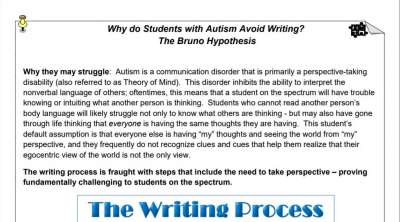
Differentiating in the Modern Classroom
-
 Christina Biasiello
Christina Biasiello
Christina Biasiello is an expert teacher with a specialized focus on working with students with exceptionalities, primarily those with Autism Spectrum Disorder.
Read on as Christina shares classroom concepts for creating a differentiated learning environment in order to reach students with a variety of needs.
Differentiating in the Modern Classroom
The concept of differentiated instruction in the learning environment is nothing new. However, differentiated teaching methods have increased in the past few years.
For centuries, teachers have known that their classrooms were broken up into thirds based on students’ needs and learning styles. Previously, every lesson a teacher taught would be too advanced for one-third, too remedial for another third, and only be on-level for the remaining third of the class. If your lesson plans did not reflect an academically diverse classroom, you were only teaching 33.3% of your students, leaving the remaining 66.7% either bored or overwhelmed.
In our new post-covid world, teachers are wishing for the “thirds rule” of the past. Today, you can have 18 students on 18 different levels. So how do you meet the needs of all of your learners when you are just one underpaid, overworked person who would still like to have a life outside of the classroom? Keep it simple. Remember that differentiated instruction can be as easy as having short individualized instruction with a struggling learner.
In this article, we’ll cover some differentiated instruction strategies to help manage your time in the classroom. We’ll help you target the needs of students in a differentiated classroom without breaking the bank or running yourself ragged.
1. Centers All Day
Most likely, you teach the four core subjects: English (or ELA), Math, Science, and Social Studies. Rather than using a one-size-fits-all approach on the whole class, consider doing a 10-15 minute mini-lesson on the day’s concept and then breaking up the students into smaller groups. This way, you can work closer with struggling learners and address their individual needs. When breaking up your students into groups, consider learning styles, learning needs, student engagement, and any learning disabilities.
I know what you may be thinking: center rotations are a struggle because the groups of students who are supposed to work independently never do. Plus, if you work with K-1 kiddos, they can barely use the computer independently!
I get it. In order for a “centers” approach to work, you’ll need to spend the first two weeks of school guiding the groups that will work independently in the future. Rotate between each group and provide the individualized instruction each requires. You will find that you will accomplish more in 15 minutes of uninterrupted instruction and get more meaningful content across, than in a regular 45-60-minute block of instruction.
While you should consider student ability when creating each group, remember that it can be helpful for a struggling learner to be paired with a successful learning buddy. Students do not have to stay at each center for the same amount of time, each can move at their own pace. Create a To-Do Checklist digitally in Google Classroom and assign students tasks. Most schools have computer programs that they want you to use for a given period of time, so you can assign a time for these programs but leave the others open-ended.
2. Center Ideas
Centers do not require a lot of prep work. Once you set up your center stations, they will pretty much always be ready to go.
Reading Centers could be:
-
Reading and taking AR tests (nonreaders could read to or listen to a book on getepic.com or Vooks.com).
-
Writing stories in the “writing center.”
-
Making a poster for a book they read to advertise it to the class.
Consider creating a fourth “empty” center that can serve as a learning station. You can pre-record lessons and have students follow along with the video as if you were leading the lesson. This will not take a lot of time to prep, you can use the same lesson for the week for struggling learners.
Math centers can run simply and smoothly as well. Use a variety of materials such as games, computer programs, worksheets, and video lessons to target different student learning styles. After each center rotation, allow students a short brain break or earned free time, depending on your school rules. They will work harder for 20 minutes with a 5-minute break than they will during a whole uninterrupted 60 minutes. The breaks actually provide more instructional time.
3. Teacher-Led Center
Do not drown yourself with differentiated instruction. Focus on one concept and break it down for your learners. For example, if the grade level standard states, “Students will identify the main idea and key details of a grade-level text,” there are many ways to accomplish this task:
-
On-level learners: These students can read a story from the provided curriculum and use a graphic organizer to identify the main idea and key details.
-
Slightly below grade level learners: This group can read a story from a text 1 to 2 grade levels below their current level. They can use a graphic organizer to identify the main idea one day and key details another day, after re-reading the text.
-
Learners several grade levels behind: These students can listen to the story that is 1 to 2 grade levels below. They can use a graphic organizer to identify the main idea.
-
Learners severely behind: These students can watch a Pixar Short or another 3 to 5-minute video and write down the main idea.
Use a variety of teaching strategies and materials to help individual students of different abilities meet grade-level standards.
So, there you have it! By creating learning centers, differentiated instruction can be accomplished easily. And remember: less is often more. Small groups + shorter lessons + brain breaks + meaningful rewards = effective instruction. By following these tips and focusing on the needs of students, you’ll reap the benefits of differentiated instruction and see significant student achievement.
Looking for more inspiration?
Discover more ideas to welcome back your students, from back to school bulletin board ideas, to back to school activities and teaching ideas, at our Back to School Headquarters.













